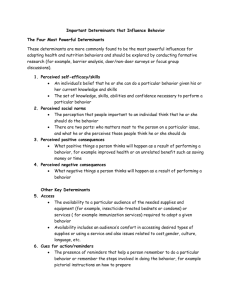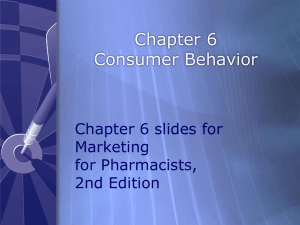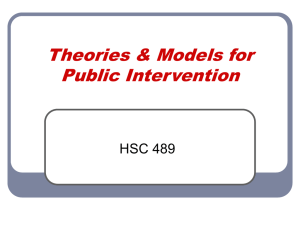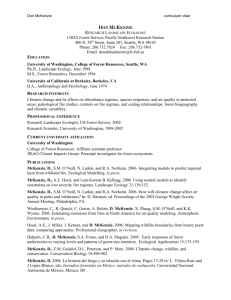Theory Choice and Description for Sun Exposure Curriculum in High
advertisement
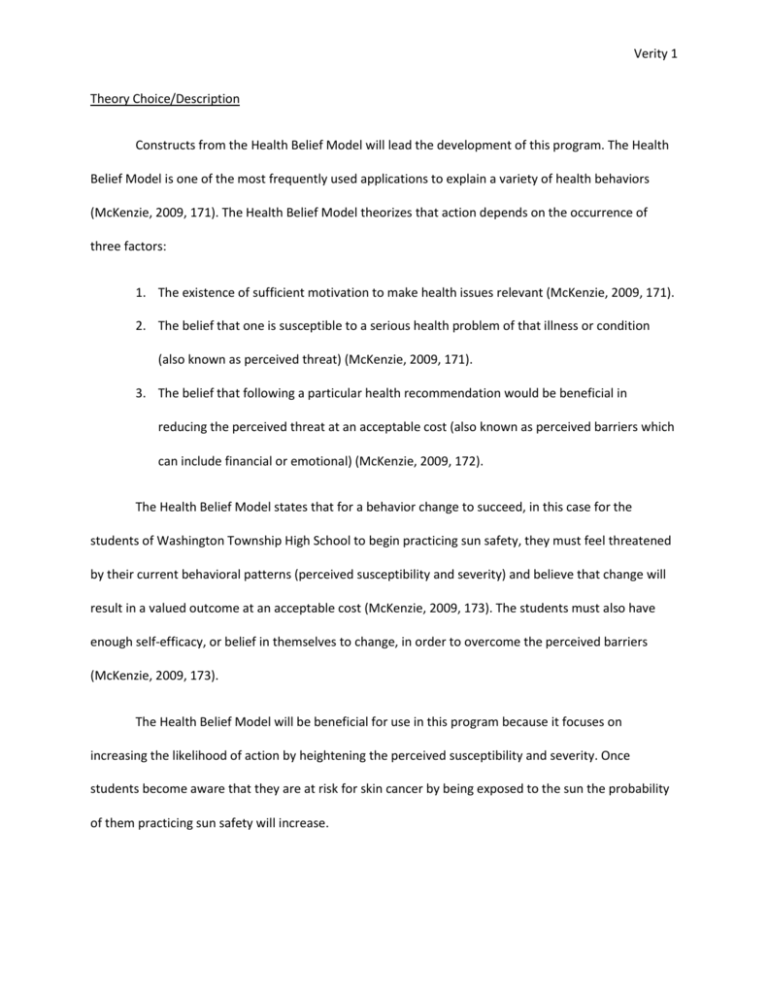
Verity 1 Theory Choice/Description Constructs from the Health Belief Model will lead the development of this program. The Health Belief Model is one of the most frequently used applications to explain a variety of health behaviors (McKenzie, 2009, 171). The Health Belief Model theorizes that action depends on the occurrence of three factors: 1. The existence of sufficient motivation to make health issues relevant (McKenzie, 2009, 171). 2. The belief that one is susceptible to a serious health problem of that illness or condition (also known as perceived threat) (McKenzie, 2009, 171). 3. The belief that following a particular health recommendation would be beneficial in reducing the perceived threat at an acceptable cost (also known as perceived barriers which can include financial or emotional) (McKenzie, 2009, 172). The Health Belief Model states that for a behavior change to succeed, in this case for the students of Washington Township High School to begin practicing sun safety, they must feel threatened by their current behavioral patterns (perceived susceptibility and severity) and believe that change will result in a valued outcome at an acceptable cost (McKenzie, 2009, 173). The students must also have enough self-efficacy, or belief in themselves to change, in order to overcome the perceived barriers (McKenzie, 2009, 173). The Health Belief Model will be beneficial for use in this program because it focuses on increasing the likelihood of action by heightening the perceived susceptibility and severity. Once students become aware that they are at risk for skin cancer by being exposed to the sun the probability of them practicing sun safety will increase. Verity 2 In order to raise awareness of the risks of sun exposure, this program will provide cues to action including but not limited to: Facts about the rates of skin cancer among younger people Mass media campaigns Presentations from a young person overcoming skin cancer and/or true stories about those dealing with skin cancer Celebrities endorsing natural, healthy skin By providing cues to action, students will begin thinking of their own habits regarding sun exposure (McKenzie, 2009, 173). There may also be some variables that cause them to think about their habits more such as demographics (Caucasian, fair skinned, young), sociopsychological (pressure to be tan), or structural (previous sunburns, knowledge of skin cancer) (McKenzie, 2009, 173). The students may then become aware that they are susceptible (perceived susceptibility) to skin cancer because of family history, risk factors (such as fair skin and freckles), a previous encounter, etc. (McKenzie, 2009, 173). The students may then realize after hearing stories from survivors that skin cancer can be very dangerous and possibly even fatal (perceived severity) (McKenzie, 2009, 173). Because of these factors, the student may realize that there is a reason to be concerned about the risks of sun exposure (perceived threat) (McKenzie, 2009, 173). The students learn that administering sunscreen of SPF 15+, avoiding tanning beds, wearing protective clothing, and early detection are a few ways to protect themselves from the sun and to keep their skin looking youthful and healthy (perceived benefits) (McKenzie, 2009, 173). The students will, however, be faced with the fact that many of their peers are tanning and believe that tanning can make one look more beautiful and healthier (perceived barriers) (McKenzie, 2009, 173). The students will then need to weigh the threat of skin cancer against the difference between benefits and barriers; this decision will result in a likelihood of taking precaution Verity 3 in the sun or continuing to tan (likelihood of taking recommended preventative action) (McKenzie, 2009, 173). The following is a theoretical conceptual model of the program (McKenzie, 2009, 172): Individual Perceptions Modifying Factors Demographic Variables (age, sex, race, ethnicity) Sociopsychological Variables (personality, social class, peer pressure) Structural Variables (knowledge about the disease, prior contact with the skin cancer) Perceived susceptibility to skin cancer and perceived severity of skin cancer Perceived threat of skin cancer Cues to action: Mass media campaigns, celebrities endorsing natural and healthy skin, hearing true stories from survivors their own age, etc. Likelihood of Action Perceived benefits of using caution with the sun minus perceived barriers to protecting themselves from the sun Likelihood of using sunscreen SPF 15+, avoiding tanning beds, and protecting themselves from sun exposure


